Georges de La Tour Biography
Georges de La Tour was born on March 13, 1593 in the town of Vic-upon-Seille, in Lorraine. His baptism document indicates that he was the son of Jean de La Tour, baker, and Sybille de La Tour, née Molian (or Malian). All Sybille’s parents and siblings were bakers. Jean’s father was a mason, but he, however, had chosen the profession of his wife’s relatives. Jean and Sybille had 7 children, Georges was the second one, the children grew in the wealthy surroundings of well-to-do artisans.
Where was George formed and what was his education, where did he spend his youth? Maybe in Vic itself, where the Swiss painter Claude Dogoz lived, or maybe at Nance, at the studio of Jacques Bellange (died in 1616). Maybe he traveled further from his house, even to Italy, but there is no evidence of it. We do not know where and who trained him. But there's evidence that young George had friends in the court of the Duke of Lorraine. In 1617, at the age of 24, he married Diane Le Nerf, who was born in 1591 into an ennobled family: her father, Jean Le Nerf, was the treasurer of the Duke of Lorraine and lived in Lunéville. The young couple settled in Vic in the parental house.
In 1619, their first son, Philippe, was born, and the next year the family moved to Lunéville. The same, 1620, year the 27-year old La Tour was apprenticed to Claude Baccarat. It is known that around 1621-23 the Duke bought a painting by La Tour, and another one in 1624, St. Peter, which he donated to decorate the church of the convent of Minimes. The same year the Duke died; with his death, military confrontations for the domination of Lorraine started among the European monarchs.
Meanwhile the family of the artist grew: in 1621 son Étienne, who would become an artist, like his father, was born; then, in 1623, daughter Claude, in 1625, daughter Mary (the 1st), in 1627, daughter Christine, in 1628, son Louis, in 1630, son Nicolas-George, in 1632, son André-George, in 1634, daughter Madeleine, in 1636, the second daughter Mary (d. in 1648), by this time the first Mary had died. The second Mary was the last child of the 45 year old Diane. In 1631, the war touched the family. La Tour became the guardian of his nephews Antoine and François Nardoyen, sons of his wife’s sister, whose husband died in the war.
At last in 1634, French domination of Lorraine was established, which brought peace, for at least a short period. The artist, along with other citizens of Lunéville, took a vow of loyalty to Louis XIII. In the document of the time he is referred to as ‘the noble George de La Tour’.
It is known that since 1636, La Tour had his own apprentices. In that year the plague, which had effected the region of Lorraine particularly severely, came to Lunéville. It struck La Tour’s household as well, one of his nephews died. To this period many art historians refer St. Sebastian Attended by St. Irene. In the 17th century, St. Sebastian was one of the most important of all patron saints. Prayers were offered to him seeking protection against disease, especially the plague.
In 1638m Lunéville was sacked and burnt, the house and studio of the artist with all its pictures were destroyed by fire. The family found shelter in Nancy.
In 1639, La Tour was in Paris by the king's order. The King presented him with 1000 francs for some service (what kind of service it was, is unknown). Though from now on he was referred to as ‘Sir George de la Tour, painter of his majesty’. In 1645, the king appointed one Henri de La Ferté-Senneterre the governor of Lorraine. The new governor loved arts. He immediately established good relations with La Tour and became his patron. He commissioned from the artist The Adoration of the Shepherds. And later he bought many paintings from La Tour, among others were: The Discovery of the Body of St. Alexis, St. Sebastian with Lantern.
On January 15, 1652 La Tour’s wife, Diane, died. Soon after her, on January 30, La Tour died, deeply depressed. In his lifetime La Tour must have been one of the most admired painters. Not many of his works survived, and these can be divided into his early ‘day pieces’, and the later ‘night pieces’. But both attributions (he only rarely signed his work) and chronological order remain questionable. To 1620-1630 belong Porridge Eaters, a row of Hurdy-Gurdy Players. The brutal realism, unflattering presentation of the miserable subjects does not at all mean a sympathetic attitude to the socially disadvantaged of the day, on the contrary, issues of this kind were intended to amuse high society, who enjoyed decorating the walls of their patrician homes with such melodramatic scenes.
Another modern topic of the day, made popular by Caravaggio, is also present in La Tour’s works. The Card-Sharp with the Ace ofDiamonds, The Card-Sharp with the Ace of Clubs, and The Fortune-Teller, compare to Carravaggio’s The Cardsharps (I Bari), The Fortune-Teller . An inexperienced, wealthy and opulently dressed young man is being cheated at cards in the dubious company of a courtesan with her lover and a servant girl. Wine and the promise of erotic adventure have made the young dandy so light-headed that he does not notice the unsubtle trick of an ace being drawn from his opponent's belt. Such depictions belonged to the moralizing genre.
Most of the canvases by La Tour we have at our disposal the art historians date after 1640. In these works La Tour is captivated with lightning effects, which do not create blurred forms but sharp contours instead. Repenting Magdalene, St. Joseph, the Carpenter. This fascination with light brought him great success in his day. However, he was completely forgotten after his death, only to be rediscovered in our own day.
La Tour is an example of how artists can pass in and out of fashion and favor of the public.
Christ and his Apostles. Little is known about this series, only 5 originals are preserved. St. James the Minor and St. Jude Thaddaeus are the only originals exhibited, as they are in good condition. Three other originals: St. Philippe, found in 1941, St. Thomas, found in 1991, and St. Andrew, found in 1991, are in bad condition, and are shown in modern copies.
There are also old copies of Christ and 5 other Apostles, fulfilled by some Louis and Jacques Bosia; and the paintings of the last 2 Apostles are lost.
Bibliography
Georges de La Tour. by I. Nemilova. Leningrad-Moscow. 1958.
Georges de La Tour. by Yu. Zolotov. Moscow. 1979.
Painting of Europe. XIII-XX centuries. Encyclopedic Dictionary. Moscow. Iskusstvo. 1999.
Georges De La Tour and His World by Philip Conisbee (Editor), Georges Du Mesnil d La Tour. Yale Univ Pr, 1996.
Georges de la Tour by Jacques Thuillier. Flammarion, 2003.
- St. Sebastian Tended By St. Irene.
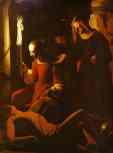
c.1634-1643. Oil on canvas. Gemäldegalerie, Berlin, Germany. Read Note.
- The Adoration Of The Shepherds.
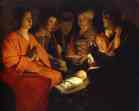
c. 1640s. Oil on canvas. Louvre, Paris, France. Read Note.
- The Discovery Of The Body Of St. Alexis.
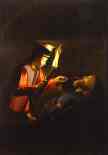
c.1640s. Copy of the lost original. Oil on canvas. National Gallery of Ireland, Dublin, Ireland.
- St. Sebastian With Lantern.
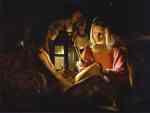
Copy of the lost original. Kimbell Art Museum, Fort Worth, TX, USA. Read Note.
- The Porridge Eaters.
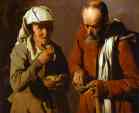
c.1622-25. Oil on canvas. Gemäldegalerie, Berlin, Germany. Read Note.
- Hurdy-Gurdy Player.
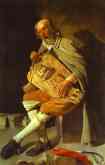
c. 1620-1630. Also called Hurdy-Gurdy Player with Hat. Musée des Beaux-Arts, Nantes, France.
- The Card-Sharp With The Ace Of Diamonds.
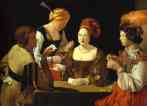
c.1636-38. Oil on canvas. Louvre, Paris, France.